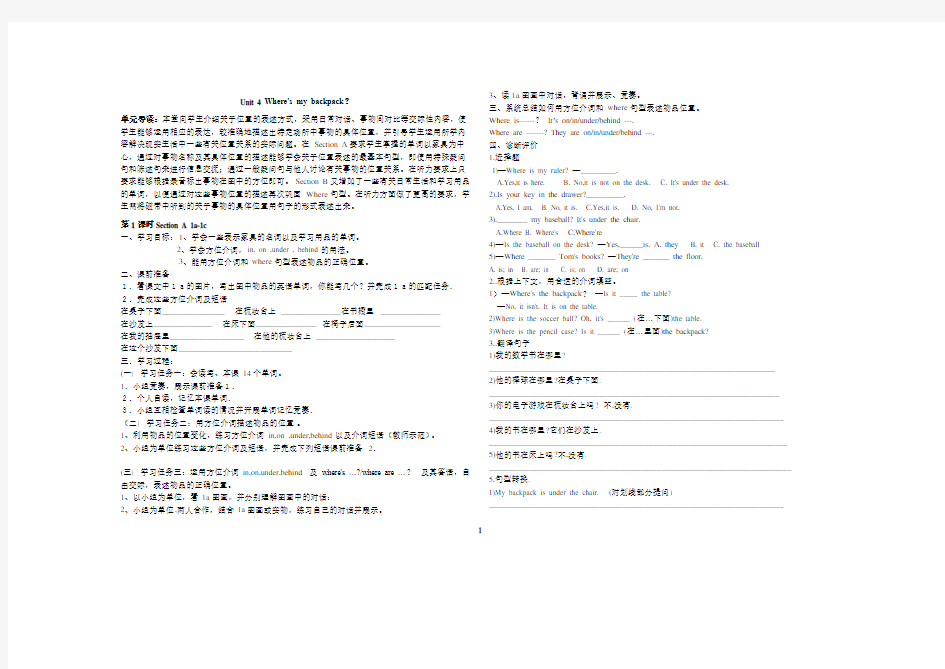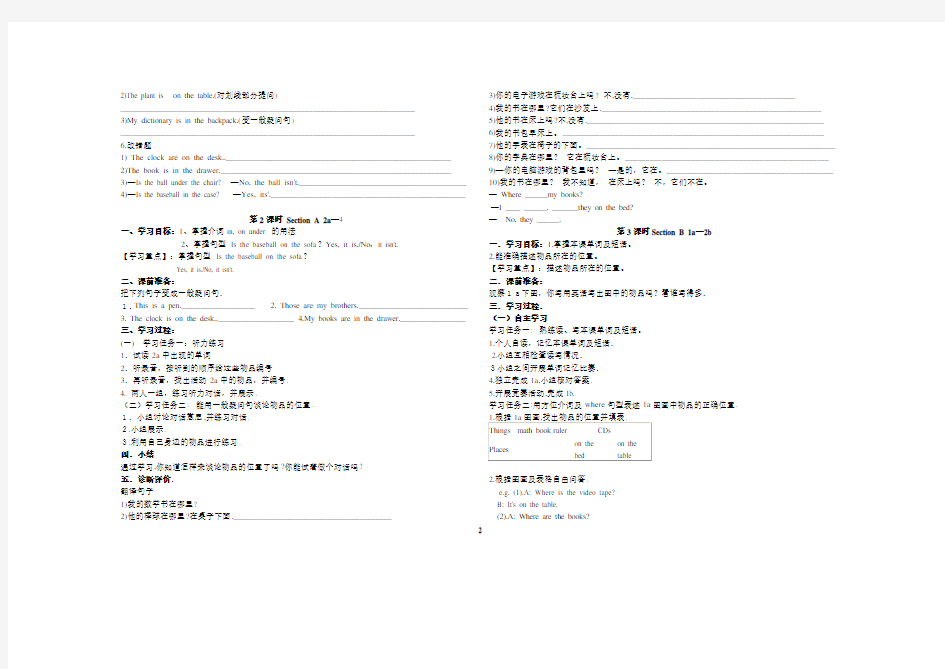

Unit 4 Where’s my backpack?
单元导读:本章向学生介绍关于位置的表述方式,采用日常对话、事物间对比等交际性内容,使学生能够运用相应的表达,较准确地描述出特定场所中事物的具体位置,并引导学生运用所学内容解决现实生活中一些有关位置关系的实际问题。在Section A要求学生掌握的单词以家具为中心,通过对事物名称及其具体位置的描述能够学会关于位置表述的最基本句型,即使用特殊疑问句和陈述句来进行信息交流;通过一般疑问句与他人讨论有关事物的位置关系。在听力要求上只要求能够根据录音标出事物在图中的方位即可。Section B又增加了一些有关日常生活和学习用品的单词,以便通过对这些事物位置的描述再次巩固Where句型。在听力方面做了更高的要求,学生需将磁带中听到的关于事物的具体位置用句子的形式表述出来。
第1课时Section A 1a-1c
一、学习目标:1、学会一些表示家具的名词以及学习用品的单词。
2、学会方位介词,in, on ,under , behind的用法。
3、能用方位介词和where句型表述物品的正确位置。
二、课前准备
1.看课文中1a的图片,写出图中物品的英语单词,你能写几个?并完成1a的匹配任务.2.完成这些方位介词及短语
在桌子下面________________ 在梳妆台上 _______________在书橱里_______________
在沙发上_______________ 在床下面_______________ 在椅子后面___________________
在我的抽屉里__________________在他的梳妆台上 ____________________
在这个沙发下面____________________________
三.学习过程:
(一) 学习任务一:会读写、本课14个单词。
1.小组竞赛,展示课前准备1.
2.个人自读,记忆本课单词.
3.小组互相检查单词读的情况并开展单词记忆竞赛.
(二) 学习任务二:用方位介词描述物品的位置。
1、利用物品的位置变化,练习方位介词in,on ,under,behind以及介词短语(教师示范)。
2、小组为单位练习这些方位介词及短语,并完成下列短语课前准备2.
(三) 学习任务三:运用方位介词in,on,under,behind 及where's …?/where are …?及其答语,自由交际,表述物品的正确位置。
1、以小组为单位,看1a图画,并分别理解图画中的对话:
2、小组为单位,两人合作,结合1a图画或实物,练习自己的对话并展示。
3、读1a图画中对话,背诵并展示、竞赛。
三、系统总结如何用方位介词和where句型表述物品位置。
Where is------?It’s on/in/under/behind ---.
Where are -------? They are on/in/under/behind ---.
四、诊断评价
1.选择题
1)—Where is my ruler? —_________.
A.Yes,it is here.
B. No,it is not on the desk.
C. It's under the desk.
2).Is your key in the drawer?__________.
A.Yes, I am.
B. No, it is.
C.Yes,it is.
D. No, I'm not.
3).________ my baseball? It's under the chair.
A.Where
B. Where's
C.Where're
4)—Is the baseball on the desk? —Yes,______is. A. they B. it C. the baseball
5)—Where _______ Tom's books? —They're _______ the floor.
A. is; in
B. are; in
C. is; on
D. are; on
2..根据上下文,用合适的介词填空。
1)—Where's the backpack?—Is it _____ the table?
—No, it isn't. It is on the table.
2)Where is the soccer ball? Oh, it's ______ (在…下面)the table.
3)Where is the pencil case? Is it ______ (在…里面)the backpack?
3..翻译句子
1)我的数学书在哪里?
______________________________________________________________________
2)他的棒球在哪里?在桌子下面.
_______________________________________________________________________
3)你的电子游戏在梳妆台上吗? 不,没有.
________________________________________________________________________
4)我的书在哪里?它们在沙发上.
_________________________________________________________________________
5)他的书在床上吗?不,没有.
__________________________________________________________________________
5.句型转换.
1)My backpack is under the chair. (对划线部分提问)
________________________________________________________________________
1
2)The plant is on the table.(对划线部分提问)
________________________________________________________________________
3)My dictionary is in the backpack.(变一般疑问句)
________________________________________________________________________
6.改错题
1) The clock are on the desk.._________________________________________________________
2)The book is in the drawer.__________________________________________________________
3)—Is the ball under the chair? —No, the ball isn't.__________________________________________
4)—Is the baseball in the case? —Yes, its'.________________________________________________
第2课时Section A 2a—4
一、学习目标:1、掌握介词in, on under 的用法
2、掌握句型Is the baseball on the sofa?Yes, it is./No,it isn't.
【学习重点】:掌握句型Is the baseball on the sofa?
Yes, it is./No, it isn't.
二、课前准备:
把下列句子变成一般疑问句.
1.This is a pen.___________________ 2. Those are my brothers.____________________________
3. The clock is on the desk..____________________
4.My books are in the drawer._________________
三、学习过程:
(一)学习任务一:听力练习
1.试读2a中出现的单词
2.听录音,按听到的顺序给这些物品编号
3.再听录音,找出活动2a中的物品,并编号.
4. 两人一组,练习听力对话,并展示.
(二)学习任务二: 能用一般疑问句谈论物品的位置.
1.小组讨论对话意思,并练习对话.
2.小组展示.
3.利用自己身边的物品进行练习.
四.小结
通过学习,你知道怎样来谈论物品的位置了吗?你能试着做个对话吗?
五.诊断评价.
翻译句子
1)我的数学书在哪里?
2)他的棒球在哪里?在桌子下面._______________________________________
3)你的电子游戏在梳妆台上吗? 不,没有.________________________________________
4)我的书在哪里?它们在沙发上.______________________________________________________
5)他的书在床上吗?不,没有.__________________________________________________________
6)我的书包早床上。________________________________________________________________
7)他的手表在椅子的下面。_____________________________________________________________
8)你的字典在哪里?它在梳妆台上。__________________________________________________
9)—你的电脑游戏的背包里吗?—是的,它在。_________________________________________
10)我的书在哪里?我不知道,在床上吗?不,它们不在。
2
B: They are on the chair.
3.听录音,并结合表格描述物品的位置,完成2b.
(二)合作共建
小组合作,描述本组内一位同学的物品的位置,写在横线上(至少五句).
三、【诊断评价】
(一)翻译官,试试看?!
一个闹钟______________ 他的数学课本_______________
in my bookcase__________ 一张学生证_________________
在我的帽子下面____________________ 在椅子上___________________
(二)选择
1.Where is Jinan? It's _____Shangdong.
A. on
B. in
C. to
D. under
2.Is your photo in the drawer?
A. Yes, I am.
B. No, it is.
C.Y es, it is.
D. No, I'm not.
三)阅读短文,判断正(T)误(F).
I am Jane.This is my room.The TV and video tape are on the table. Where is my backpack?
It isn't on the table.Oh!It's on the bed.My pencils aren't on the table.They are in my pencil case and it's in my backpack.My computer games are under the chair.My alarm clock,my ID card and my keys are on the dresser.
( )1.Her video tapes are on the TV.
( )2.Her backpack isn't on the bed.
( )3.Her pencils are in the pencil case.
( )4.Her pencil case isn't in her backpack.
( )5.Her ID card is on the desser.
第4课时Section B 3a—4
一.学习目标:1.掌握本节的重点单词和短语
2.掌握便条的书写格式以及如何写便条
【学习重点】:会写便条
二.课前准备
1.本节3a是grandma写给feifei的一张便条,便条中不仅说明了要带哪些物品,还依次说明了物品的位置,请从便条中找出这些信息吧.
(1) hat________________________
(2) watch______________________
(3) notebook______________________
(4) keys___________________________
(5) ID card_________________________
2. Please take these things to your sister.
句中的take用作动词,意思是"带,拿走"take 常与to连用,构成"take --- to---",表示"把------带到------"例如:Please take the books to the library.
辨析:take与bring
请观察下列例句:a. Take the dictionary to your school, you need it.
b. Tom brings some books to my home.
你得出了什么结论呢?__________________________________________________________.
_______________________________________________________________________________
3. Can you bring some things to school?
(1)句中的can为情态动词,表示"可以,能,会"后面接动词原形."Can you---?"表示"你能------
吗?"此时,在句中常用some,不用any.例如:Can you bring me some pencils?
(2)"给某人带东西"可以说“bring sb. sth..”或"bring sth. to sb”例如:Please bring me your math
book.=_________________________________________________________________.
二.学习过程
(一)、自主学习
学习任务一: 熟悉掌握本课12个单词
1、自读并记忆单词2分钟
2、两人一组,相互提问
3、展示交流,小组竞赛
拿走;带到________ 东西,物________ 妈妈________ 能,可以,会_______
拿来,取来,带来________ 一些,若干_______ 需要________ 地板,地面_______
房间________ 电视,电视机________ 书桌,课桌________
学习任务二: 掌握便条的书写格式
(一)1、个人自读3a中的便条.
2、小组合作,翻译短文.
take┅to┅_
翻译:把这块橡皮给你的弟弟_________________________________
把这块表带到房间里. ___________________________________
3、小组合作,讨论便条的格式,并写在下方.
4、展示交流
(二)1、独立完成3b
2、小组核对答案,并试着翻译短文
3、小组合作,讨论bring┅to ┅的用法
翻译:把你的电子游戏带到学校里来。
3
二、合作共建 : 小组讨论take┅to┅和bring┅to┅的区别
三、系统总结: 总结便条的格式
四、诊断评价
1、写出下列短语
在梳妆台上 ___________ 在床下_____________ 在抽屉里______________ 身份证 ______________ 把...带到________________ 把...拿到______________ 一些东西 _________________ 在地板上____________________
2、选择
(1)Can you_______these things to your brother, Tom?
A. take
B. bring
C. fetch
D. carry
(2)—Where's Shanghai? —It's______China.
A. in
B. in the
C. at
D. on
(3)These are my______. A. key B. keys C. keies D. keyes
3、假如你是Bob,写张便条,告诉Tom把下列东西带给你的朋友,Mary。
CDs(in the dresser) computer game(on the desk) a set of keys(in the backpack)
Hat(on the chair)
第5课时Self -Check
【学习目标】:1、复习掌握本单元的单词。
2、学会询问及描述物品的具体位置。
3、学会写便条。
【学习重点】:方位介词和where句型表述物品的正确位置。
【学习过程】:
一、自主学习
学习任务一:会读、写本单元生词表中32个单词。
1、自读并记忆单词5分钟。
2、两人一组,互相检查。
3、展示交流,小组竞赛(以听写形式进行展示)
物品:桌子______床______梳妆台_______书橱_______沙发______椅子______抽屉________书包________录音带________光盘________
介词:在……上_____在……里_____在……下______在……后面________
其它:拿走;带到______拿来;取来_______需要_______房间_______
学习任务二:用in,on,under,behind和where句型表述物品的具体位置.
1、学生个人思考并完成下列短语。
在床下面_____________在梳妆台上____________在椅子后面______________
在书橱里____________在他的双肩背包里___________在她的抽屉里________
在我的书包里_________
2、小组核对答案,并结合以上短语总结介词短语的结构_______________________
3、两人一组理解并练习下面的对话。
A:Where are my books? B:Sorry,I don`t know.
A:Are they on the bed? B:No,they aren`t.
A:Are they under the chair? B:Yes,they are.
4、结合上面的对话,组内合作,练习自己的对话,并展示。
5、看课本Section B1a图画,描述图中物品的具体位置。
(e.g. The math book is on the dresser.)请再写下两个句子:
学习任务三:写便条。
1、理解下列句子,总结the的用法。
I have(有)a notebook.The notebook is on the desk.
总结:the________________________________________________
2、假如你是Bob,写张便条,告诉Tom把下列东西带给你的朋友,Mary。
二、合作共建
结合句子:The baseball is in the backpack.
The books are on the bed.
思考描述物体位置时,需要注意什么?不要忘了______以及名词前面的______.
三、系统总结
1、询问物体位置的句型及其回答。
2、便条格式。
四、诊断评价
(一)选择
1. Please_________your math books to school this afternoon,boys and girls.
A、take
B、bring
C、be
2. I_______know his name. A、am not B、don`t C、isn`t
3. Where are _______tapes?
________are under the desk.
A、you;Your
B、my;It
C、my;They
D、the;The
(二)根据要求改写句子
1. don`t I name his know (.)(连词成句)
2. The CDs are on the dresser.(提问划线部分) the CDs?
3. on,table,the,book,is,your (?)(连词成句)?
4